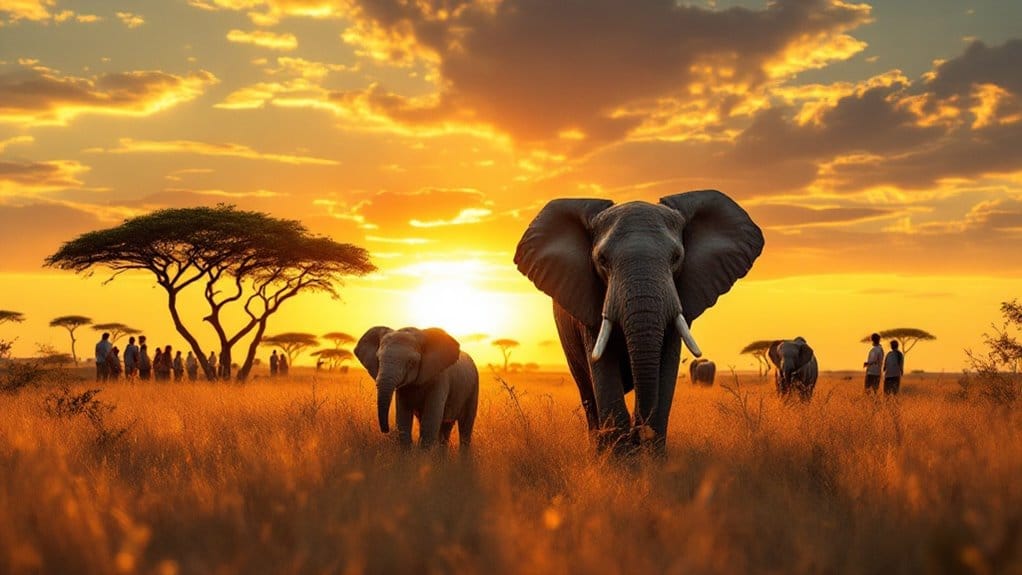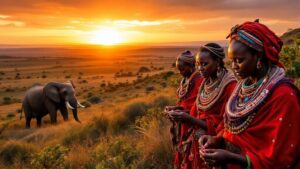Like explorers of old, you stand on the brink of a journey that intertwines adventure with purpose. African Heritage Tours offer you a chance to engage directly with wildlife conservation efforts, allowing you to witness the delicate balance of nature firsthand. Imagine participating in projects that not only protect endangered species but also strengthen local communities. What unique experiences await you in the heart of Africa, and how can your involvement make a lasting impact?
Key Takeaways
- African Heritage Tours offer immersive experiences that prioritize wildlife conservation and support endangered species through educational travel initiatives.
- Tours include unique wildlife encounters, such as trekking with mountain gorillas and witnessing the Great Wildebeest Migration.
- Community engagement is central to these tours, fostering sustainable practices that benefit local populations and promote conservation efforts.
- Travelers can participate in hands-on conservation activities, like health checks for endangered species, enhancing their connection to wildlife.
- The tours align with global sustainability goals, advocating for responsible tourism and the preservation of Africa's rich biodiversity.
Overview of Conservation Initiatives
Wildlife conservation initiatives are more essential than ever, and companies like African Travel, Inc. are leading the charge. With nearly 100 Make Travel Matter experiences across 16 African destinations, they're not just focusing on adventure; they're committed to meaningful conservation and community development.
By partnering with organizations like Vulpro and the Cheetah Conservation Fund, they're actively working to protect endangered species, such as vultures and cheetahs, whose populations have plummeted.
When you set out on a safari with African Travel, Inc., you're contributing to local education and wildlife conservation projects. This means your travel not only enriches your life but also positively impacts the environment and the communities you visit.
Conservation tourism becomes a force for good, as these immersive experiences educate you on sustainable practices and the importance of safeguarding Africa's natural heritage.
Moreover, collaboration with The TreadRight Foundation reinforces their commitment to sustainability, aligning with the UN Sustainability Development Goals.
Unique Wildlife Encounters
Starting on a wildlife conservation tour opens the door to unforgettable encounters that connect you with the wonders of nature while supporting crucial conservation efforts.
Imagine trekking through lush forests in Uganda, Congo, or Rwanda, where you come face-to-face with majestic mountain gorillas. Your permit fees directly fund habitat management and ranger salaries, ensuring these endangered wildlife thrive.
In Botswana, you can interact with habituated meerkats, witnessing their playful antics while contributing to local community development.
Or, venture to Mozambique's Bazaruto National Park for a rare sighting of dugongs, where fewer than 400 remain, highlighting the urgent need for conservation.
South Africa offers hands-on conservation experiences, allowing you to conduct health checks on pangolins or track elephants and rhinos. Each interaction deepens your understanding of wildlife preservation efforts.
Lastly, don't miss the breathtaking annual bat migration at Kasanka National Park in Zambia, where around 8 million bats take flight, showcasing the critical role of biodiversity.
Community Engagement in Conservation
When you engage with local communities during your wildlife conservation tours, you're not just a visitor—you're a crucial part of sustainable practices that benefit both the environment and the people who live there.
By supporting community-based initiatives, you help guarantee that locals gain economic advantages while actively participating in preserving their natural heritage.
This collaboration creates a stronger, more effective approach to wildlife conservation that empowers everyone involved.
Local Community Involvement
Local communities' involvement in conservation plays an essential role in the success of wildlife preservation efforts. When you engage with community-based tourism initiatives, you not only empower local communities but also actively contribute to sustainable practices that benefit both people and endangered animals.
Here's a quick look at how local communities enhance conservation efforts:
| Community Involvement | Benefits |
|---|---|
| Educational programs | Raise awareness about biodiversity |
| Hands-on experiences | Directly aid wildlife preservation |
| Collaboration with local groups | Align conservation with community needs |
By participating in educational programs, you foster understanding of the importance of protecting endangered species. Furthermore, hands-on experiences, like monitoring animals and assisting with data collection, allow you to make a tangible difference.
Collaborating with local organizations guarantees that conservation efforts not only protect wildlife but also enhance community livelihoods. This sense of belonging and contribution creates a positive impact on both wildlife and the people who call these beautiful places home. Join us in supporting local communities; together, we can achieve sustainable conservation and celebrate Africa's rich natural heritage.
Sustainable Conservation Practices
Sustainable conservation practices thrive on the collaboration between travelers and local communities, creating a powerful synergy that benefits both wildlife and people.
When you begin a safari, you're not just witnessing stunning landscapes and majestic animals; you're actively participating in conservation experiences in South Africa that empower local populations. Community-based tourism initiatives guarantee that the economic benefits of wildlife tourism flow directly to those who live alongside endangered species, fostering a sense of ownership and responsibility toward their natural heritage.
By engaging in hands-on experiences, like health checks for endangered species, you deepen your connection with nature while directly contributing to wildlife preservation.
These unique opportunities allow you to participate in wildlife research and monitoring projects, expanding your understanding of local biodiversity and the importance of protecting ecosystems.
Moreover, educational programs raise awareness about conservation, encouraging local communities to engage actively in their environment.
Your conscious travel choices not only support sustainable practices but also enhance community development.
Together, we can create a positive impact on both wildlife and the people who dedicate their lives to safeguarding it.
Join this journey and be part of something truly transformative.
Migration Experiences
You won't want to miss the breathtaking spectacle of the Great Wildebeest Migration, where over 2 million animals traverse the Serengeti and Masai Mara in search of greener pastures.
Equally fascinating is Zambia's Bat Migration, featuring 8 million bats that journey to feast on wild fruit, showcasing the incredible diversity of Africa's wildlife.
These migration experiences not only reveal the seasonal patterns of these species but also highlight the urgent need for conservation efforts to protect their habitats.
Great Wildebeest Migration Insights
As the sun rises over the Serengeti, the Great Wildebeest Migration unfolds in a breathtaking spectacle that captivates nature lovers and adventure seekers alike.
Picture yourself amidst over 2 million animals, including wildebeest, zebras, and gazelles, as they traverse the iconic landscapes of the Serengeti and Masai Mara ecosystems. This incredible wildlife event isn't just about the dramatic river crossings in July; it's a year-round journey filled with highlights that promise unforgettable moments.
Witnessing calving season in February, when around 500,000 calves are born within two weeks, shows the raw beauty of nature and the critical survival of the species.
Every visit to this safari destination offers unique conservation experiences in South Africa, allowing you to connect with the land and its creatures.
Participating in the migration not only enriches your soul but also contributes to local economies and conservation efforts, making your adventure meaningful.
Join fellow enthusiasts and embrace the thrill of the great wildebeest migration—it's an experience that deepens your appreciation for our planet and its incredible wildlife.
Don't miss this chance to be a part of nature's most spectacular event!
Unique Bat Migration Events
Nestled between the lush landscapes of Zambia's Kasanka National Park, a mesmerizing spectacle unfolds each year when an estimated 8 million straw-colored fruit bats commence on their incredible migration from the Congo.
This extraordinary event, occurring from October to December, transforms the park into one of the best destinations for wildlife enthusiasts seeking unforgettable experiences.
As you witness this massive migration, you'll find yourself immersed in a vibrant display of nature, where the bats play a crucial role in pollinating plants and dispersing seeds.
Not only is this a breathtaking sight, but it also highlights essential conservation experiences in South Africa and beyond.
Engaging in this unique migration event offers you an opportunity to learn about the ecological significance of bats within African ecosystems.
It's a chance to connect with nature and understand the pressing need for conservation efforts to protect these remarkable creatures and their habitats.
Pair your visit with a thrilling game drive, exploring the rich wildlife that calls this park home.
Don't miss out on this incredible experience that promises to deepen your appreciation for the wonders of our natural world.
Coastal and Aquatic Wildlife
Exploring coastal and aquatic wildlife offers a unique glimpse into some of nature's most fascinating creatures and their habitats. Imagine witnessing the incredible journey of sea turtle hatchlings as they instinctively navigate towards the ocean, a remarkable event that occurs on East Africa's coast from November to January. This is just one of the many unforgettable conservation experiences in South Africa that connect you to the natural world.
At Boulders Beach, you can get within a meter of the charming African penguins, watching their playful antics from raised boardwalks. There's something magical about being so close to these endangered birds.
In Hermanus, you can marvel at majestic whales breaching the surface from early June to December, with stunning cliff pathways offering the perfect view for unforgettable sightings.
Additionally, Bazaruto National Park in Mozambique highlights vital conservation efforts for the endangered dugong, a large marine mammal facing significant threats.
Planning Your Safari Adventure
After experiencing the wonders of coastal and aquatic wildlife, it's time to focus on planning your safari adventure, a journey that promises unforgettable encounters with Africa's iconic animals.
With the right preparation, you can immerse yourself in luxury and conservation experiences in South Africa, making a lasting impact.
Here are three vital steps for planning your safari:
- Choose Your Destination: Research various national parks and Private Game Reserves. Each offers unique wildlife and landscapes, ensuring you find the perfect fit for your interests.
- Personalize Your Itinerary: Take advantage of the opportunity to craft a personalized itinerary. Focus on your preferences, whether you're seeking thrilling game drives or serene nature walks.
- Consider Ideal Travel Times: Timing is essential! Look into seasonal wildlife patterns and activities at different locations to maximize your experience.
Starting your adventure can be easy with a minimal deposit of $100, allowing you to secure your spot and enjoy flexible payment options.
Thorough support throughout the planning process guarantees you'll be well-prepared for this extraordinary journey into Africa's heart.
Your dream safari awaits!
Frequently Asked Questions
What Is the Best Time of Year for Wildlife Tours in Africa?
The best time for wildlife tours in Africa really depends on what you want to see.
Generally, the dry season, from June to October, offers prime viewing opportunities as animals gather around water sources.
You'll experience unique encounters with migration patterns, especially in places like the Serengeti.
Plus, seasonal pricing can make trips more affordable during the shoulder months.
Choose your timing wisely for unforgettable adventures in the best wildlife destinations!
Are These Tours Suitable for Families With Young Children?
Yes, these tours are perfect for families with young children!
You'll find plenty of family-friendly activities that keep everyone engaged. The tours prioritize child safety measures, ensuring a worry-free experience.
Plus, wildlife education programs are designed to captivate young minds, making learning fun. With interactive experiences, your kids can connect with nature and wildlife, fostering a sense of belonging and appreciation for the environment.
It's a memorable adventure the whole family will cherish!
What Should I Pack for an African Heritage Tour?
When you're packing for your trip, consider bringing essential gear like sturdy walking shoes and a lightweight backpack.
Don't forget your wildlife photography equipment to capture those stunning moments!
Include items for cultural experiences, such as a journal or sketchbook.
Finally, health precautions are key—pack any necessary medications, sunscreen, and insect repellent.
With these essentials, you'll be ready for an unforgettable adventure that connects you with nature and culture.
How Do I Choose a Responsible Tour Operator?
Choosing a responsible tour operator means prioritizing eco-friendly practices and community involvement.
Look for operators that actively support local cultures and promote wildlife ethics, ensuring animals are treated humanely.
Research their commitment to sustainability and cultural sensitivity; it shows they value both the environment and the communities you'll visit.
What Types of Accommodations Are Available During the Tours?
When you commence your adventure, think of accommodations as cozy nests waiting to embrace you.
You've got choices! Luxurious lodges pamper you with comfort, while eco-friendly camps let you connect with nature.
If you crave the wild essence, safari tents offer an intimate experience under the stars.
For a taste of local life, cultural homestays wrap you in the warmth of community.
Whichever you choose, you'll find a place that feels like home.
Conclusion
Starting on an African Heritage Tour is like stepping into a living tapestry woven with vibrant wildlife and rich cultures. By participating in these conservation initiatives, you're not just observing nature; you're actively playing a role in its preservation. Your journey can ignite a passion for sustainability and inspire positive change. So, whether you're marveling at the Great Migration or engaging with local communities, every moment contributes to a brighter future for Africa's incredible biodiversity.




